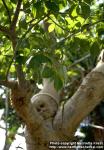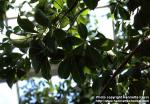
 The bark of Adansonia digitata, Linné.
The bark of Adansonia digitata, Linné.
Nat. Ord.—Malvaceae.
COMMON NAMES.—Baobab, Monkey-bread tree, Sour-gourd tree, Cream-of-tartar tree.
ILLUSTRATIONS.—Bot. Mag., Pl. 2791 and 2792.
Botanical Source and History.—Adansonia digitata is a large tree of the western coast of Africa and Egypt, sometimes attaining huge dimensions, being often 25 feet in diameter, although the height is not nearly so great in proportion. It was formerly supposed to attain a great age, and Adanson, a French botanist, in whose honor the tree was named, estimated a tree on the islands of Cape de Verd to be over 5,000 years old, a point disputed by Bentham, who asserts that A. digitata is of rapid growth and comparatively short-lived. It is the baobab tree of travelers, and also known as monkey-bread, cream of tartar tree, and sour-gourd tree. The local name is Gowik Chentz or Churee Chentz.
The leaves are digitate, and consist of five acute elliptical leaflets, resembling the leaves of our common buckeye. The flowers are very large and suspended on long peduncles; the calyx not having the peculiar involucre at its base which characterizes many genera of the Malvaceae. The style is long, exserted from the staminal column, and bears a 10-rayed stigma. The fruit, which is nearly a foot long, is divided into 10 cells filled with an agreeably acid pulp in which the seed are imbedded.
The baobab tree belongs to the section Bombaceae, of the natural order Malvaceae, by De Candolle considered sufficiently distinct to form a separate natural order, which differs from Malveae (the typical form of Malvaceae) in having the calyx imbricated in the bud, and the staminiferous tube divided into five bundles at the apex; whereas the stamens of the Malveae are perfectly monadelphous. The fruit of this tree, which is cucumber- or bottle-shaped, is used by the natives for fishing-net floats and as water vessels. The native Africans employ the cream-of-tartar-like or sub-acid, mucilaginous pulp as a remedy for dysentery, and poultice inflammations with the leaves. They also use to control excessive perspiration a powder (called Lalo) of the dried leaves. Combined with buttermilk it is used in Bombay for its astringent effect in dysentery and diarrhoea, and the sub-acid pulp is given with figs by the Concans for asthma (Dymock).
Description.—The bark is the part employed, and, together with the leaves and flowers of the tree, contains much mucilaginous matter. When fresh it is about five-eighths of an inch in thickness, brown, with a rough epidermis. A section shows the structure to consist of a mixture of pitted wood cells devoid of general arrangement. The cut surface of a transverse section is mottled yellowish-green, and reddish-brown, uniting with the woody fiber of the trunk.
Chemical Composition.—The decoction of the bark decomposes rapidly, owing to the mucilaginous material present; however, this may be prevented by the addition of alcohol, or a small quantity of sulphuric acid. By treatment with alcohol, subsequently evaporating, then digesting with litharge, and extracting with ether, upon evaporating the ether white needles of an extremely bitter taste are obtained, named adansonin. These are fusible, dissolve in 6 parts of cold and 3 of boiling ether, are soluble in alcohol, and but slightly so in water; they are not precipitated from their solution by alkalies, and chloride of iron imparts a greenish tinge to the alcoholic solution. Their formula is C48H36O33 (Wittstein). Acid malate of potassium, glucose, pectin, and tartaric acid have been found in the pulpy substance surrounding the seeds.
Action, Medical Uses, and Dosage.—According to M. Duchassaing, the bark of this tree possesses febrifuge properties, and although devoid of bitterness, may be beneficially substituted for cinchona; since its introduction into our markets, no satisfactory report has been made of its virtues in this respect. The juice of the fruit is stated to be employed in its native country as a remedy in putrid and pestilential fevers; and a decoction of the nut, in dysentery. A decoction of the bark (1 oz. in 1 quart of water boiled to 1 ½ pints) is of a reddish color, somewhat resembling that of decoction of cinchona (Comp. Rend., xxvi, 1848, and Jour. de Pharm., June, 1845). A pint and a half of the decoction may be taken in a day.

